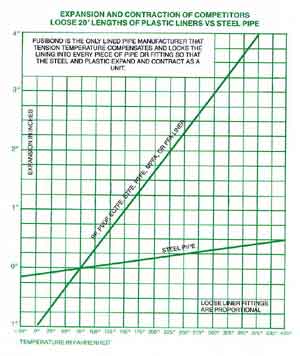
Fusibond Piping
Systems, Inc.
2615 W. Curtiss
Downers Grove, IL
60515
630-969-4488 (Voice)
630-969-2355 (Fax)
Copyright © 2000
Fusibond Piping
Systems
All Rights Reserved
Site Design by
Northern Webs
 |

Liner- Loose vs. Locked-In
PIPE
Plastic lined pipe can be fabricated with either a loose or locked in liner. A
locked in liner reduces the effect of the difference in expansion
coefficient between the metal and the liner. A loose liner, when
extensively thermal cycled, can result in cracking at the flange
surface since that is the only place where the liner is restrained.
Loose liners tend to roll back and forth at the flanges when heated
to an elevated temperature due to the differences in expansion between
the metal and liner. Loose liners tend to collapse when operated
under high vacuum at elevated temperatures. In addition, loose liners
provide a space for gas build-up between the liner and the pipe
and result in corrosion and liner collapse. Weep holes which can
be used to initially prevent this problem are readily blocked by
paint, rust, and insulating materials. Weep holes can also create
problems of structural corrosion of the metal pipe. Weep holes are
commonly used with PTFE and FEP due to the poor permeation characteristics.
MPFA/PFA does not always need to be vented.
FITTINGS
For plastic lined pipe to be practical and viable, a total system is required
including tees, elbows, crosses, standard reducing and special
configurations. The method of fabrication of the plastic lined
fittings is key to the total system reliability. The ASTM
specifies that no welding is permitted on the fitting after
the liner is molded into place. Some of the lined fittings
on the market do not comply with this part of the ASTM with
a resulting loss in reliability.
PRESSURE AND VACUUM LIMITATIONS
Plastic lined pipe is available in 150 and 300 pound pressure rated pipe. Higher
pressure pipe is available on special order. Bonded lined
pipe can operate at full vacuum. Vacuum collapse capability
of loose lined pipe is dependent on liner thickness.
|

Click on image for larger view
|
|

|

![]()



